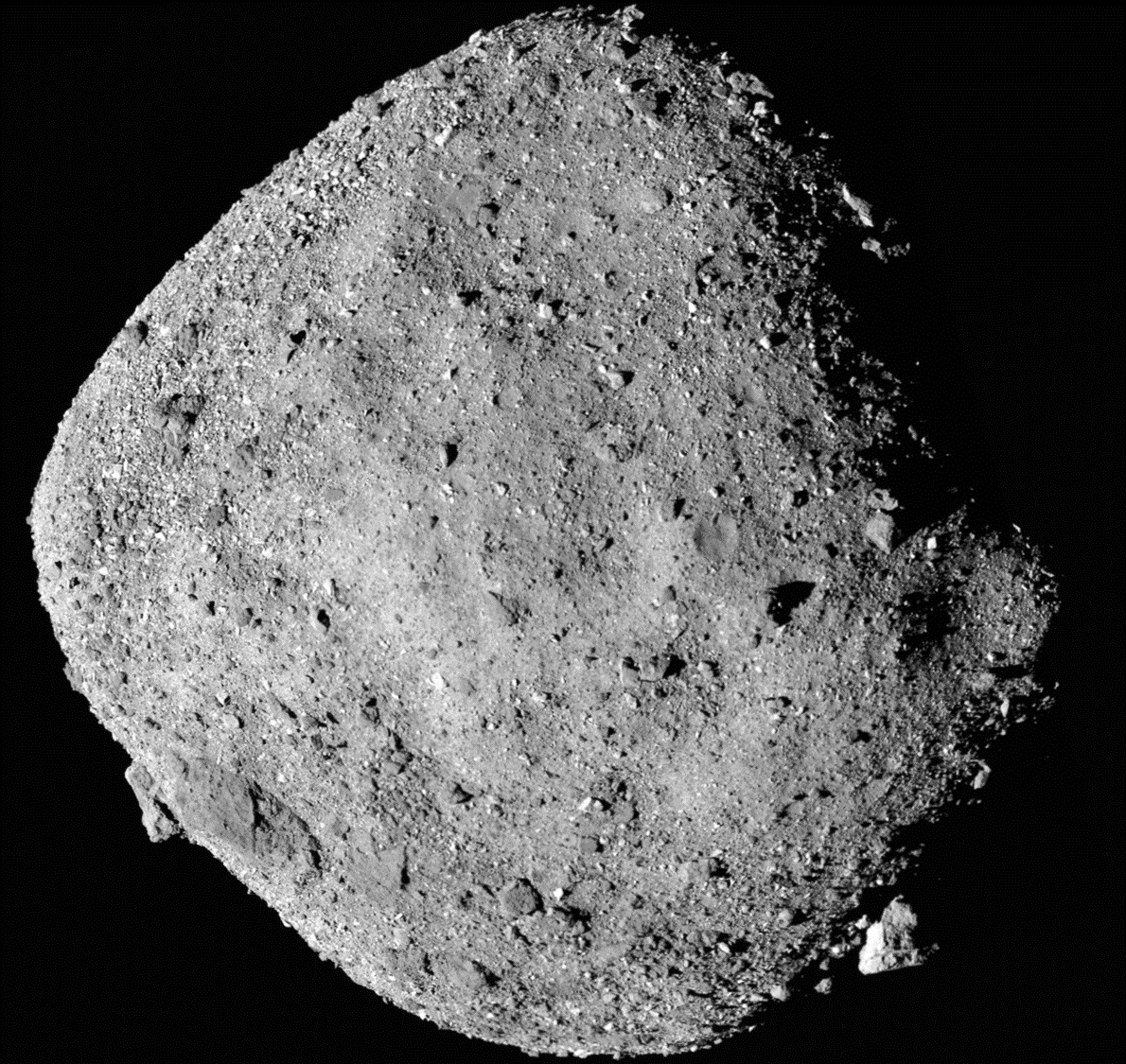
Close-up observations of the near-Earth asteroid Bennu have revealed many surprises, NASA announced today during the 50th Lunar and Planetary Conference in Houston. These include particle plumes and a much more rugged surface than had been anticipated.
The findings come from the Origins, Spectral Interpretation, Resource Identification, Security-Regolith Explorer (OSIRIS-REx) spacecraft, which entered orbit around Bennu on December. 31, 2018.
One of the most interesting discoveries has been the plumes – the first-ever observation of such plumes – also called “ejection events” – erupting from the surface of an asteroid. They were seen in images taken by the spacecraft when it was about one mile (1.61 kilometers) from the asteroid. Plumes are, of course, well-known on comets, and even icy moons like Enceladus and possibly Europa, but until now had not been seen on an asteroid. Scientists don’t know the cause yet for the plumes on such a small body – Bennu is only about 0.306 miles (492 meters) across.
“The discovery of plumes is one of the biggest surprises of my scientific career,” said Dante Lauretta, OSIRIS-REx principal investigator at the University of Arizona, Tucson. “And the rugged terrain went against all of our predictions. Bennu is already surprising us, and our exciting journey there is just getting started.”

“The first three months of OSIRIS-REx’s up-close investigation of Bennu have reminded us what discovery is all about — surprises, quick thinking, and flexibility,” said Lori Glaze, acting director of the Planetary Science Division at NASA Headquarters in Washington. “We study asteroids like Bennu to learn about the origin of the solar system. OSIRIS-REx’s sample will help us answer some of the biggest questions about where we come from.”
The particle plumes were discovered on Jan. 6, 2019, and observed multiple times during the next couple months. Some of the particles even orbited Bennu as tiny “satellites” before settling back on the surface again.
Fortunately, none of the particles pose a danger to the spacecraft.
The other primary discovery was that Bennu’s surface is much more rugged than expected, literally covered with boulders. Scientists had thought the surface would be smoother, with fewer boulders, based on telescopic and radar observations from Earth. But as often happens in planetary missions, the truth turned out to be rather different.
OSIRIS-REx is scheduled to return a sample of Bennu to Earth in 2023, with the sample collection done in the summer of 2020. The high density of boulders, however, will make the sample collection – Touch-and-Go (TAG) – a bit more tricky. It can still be done, but the sample site will need to be much smaller than first calculated. The anticipated sample site had an 82-foot (25-meter) radius, but will now have to be significantly reduced in order to avoid large boulders. The new sample collection process will now be called Bullseye Touch-and-Go.

“Throughout OSIRIS-REx’s operations near Bennu, our spacecraft and operations team have demonstrated that we can achieve system performance that beats design requirements,” said Rich Burns, the project manager of OSIRIS-REx at NASA’s Goddard Space Flight Center in Greenbelt, Maryland. “Bennu has issued us a challenge to deal with its rugged terrain, and we are confident that OSIRIS-REx is up to the task.”
There is also now evidence for thermal fracturing on Bennu, where the boulders forms cracks and break into smaller pieces.
“Based on what we’re seeing in these images, we believe rock breakdown due to thermal fracturing is happening on Bennu. What is really exciting is that this is the first time we’re observing direct evidence for this process on a planetary surface,” said Planetary Science Institute Research Scientist Jamie Molaro.
Another key finding is that of water-bearing minerals on Bennu, similar to those on carbonaceous chondrites.
“Scientists are interested in the composition of Bennu because similar objects may have seeded the Earth with water and organic materials,” said SwRI’s Dr. Victoria Hamilton, a mission co-investigator and lead author of a paper outlining the discovery published March 19 in Nature Astronomy. “OSIRIS-REx data confirm previous ground-based observations pointing to aqueously altered, hydrated minerals on the surface of the asteroid.”

“During planetary formation, scientists believe that water was one of many chemical components that accreted to form Earth; however, most scientists think additional water was delivered in part by comets and pieces of asteroids, including water-bearing carbonaceous meteorites,” Hamilton said. “Many of these meteorites also contain prebiotic organic chemicals and amino acids, which are precursors to the origin of life. The details of water delivery to Earth as well as the larger issue of the different inventories of water ice in the early solar system affect how we view solar system formation.”
OSIRIS-REx also found that Bennu’s rotation is slowly increasing in speed, due to uneven heating and cooling as it rotates in sunlight – the Yarkovsky-O’Keefe-Radzievskii-Paddack (YORP) effect. As a result, Bennu’s rotation period is decreasing by about one second every 100 years.
The study of Bennu by OSIRIS-Rex is not only providing fascinating details about the asteroid itself, but also valuable clues as to how asteroids in general formed billions of years ago.
More information about OSIRIS-REx is available on the mission website.
.
.
FOLLOW AmericaSpace on Facebook and Twitter!
.
.
Missions » OSIRIS-REx »





I am surprised that the boulders on Bennu are high density. The reason for my surprise is that my understanding is that these boulders would have formed from light aggregate in the solar systems early history. There has never been much gravitational pressure to compact anything.